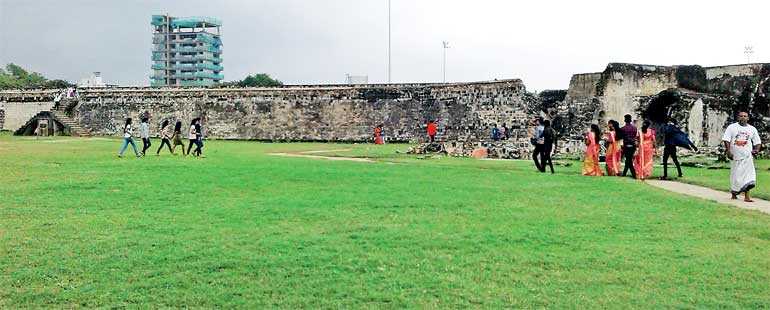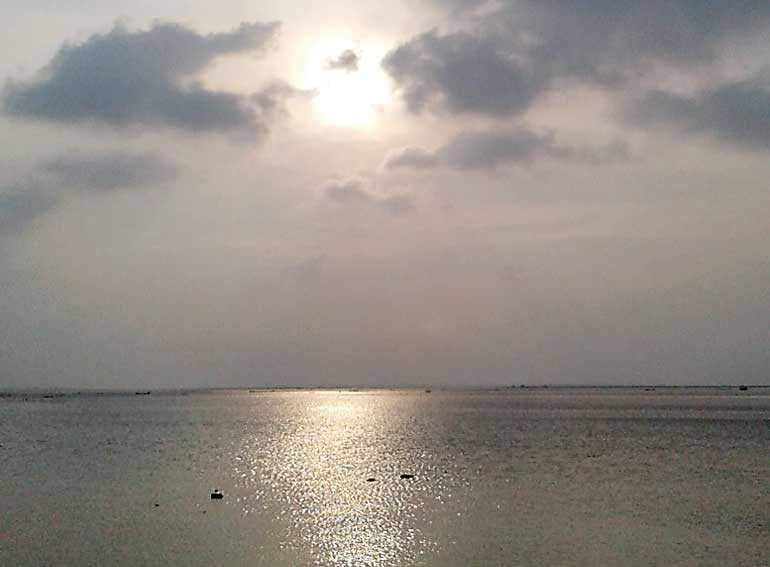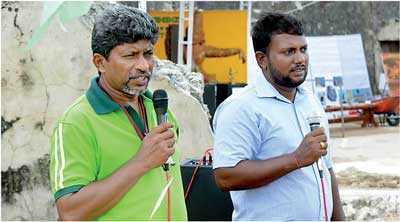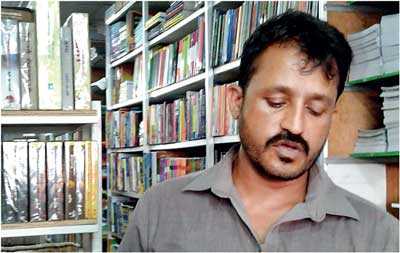Monday Jun 30, 2025
Monday Jun 30, 2025
Friday, 11 January 2019 00:19 - - {{hitsCtrl.values.hits}}



By Frances Bulathsinghala
It is after some months that I visited Jaffna three weeks back, to spend the holiday season. As in almost every visit, I make it a point to go to the Jaffna Public Library. Every time I climb those steps, it is with reverence mixed with a deep sadness.
 |
Jaffna Central Cultural Fund office Assistant Director Laxman C. Maithripala (left) and Jaffna Fort Archeology Deputy in Charge K. Kabilan |
 |
Piyasena (left) and Yuvarasa fishermen of Pasaiyoor who lament the mystery of disappearing fish |
 |
Sangarapillai Naguleswaran, food preserving expert and founder of the Jaffna health food brand Nutrifoods, poses with his granddaughter in his office |
 |
A.S. Roy, Manager of the Quency Bookshop in Jaffna, a leading supplier of educational material to leading bookshops in Colombo |
 |
Padmasri sells clothes purchased from Maharagama |
Reverence because the Hindu culture looks at knowledge as sacred, combining book knowledge with spiritual knowledge. Sadness, because Sinhalese politicians had stooped to the lowest of the low in 1981 to instigate mobs to burn this hallowed place of knowledge. They had thereby laid the foundation for mistrust and unrest, which fuelled by the 1983 anti-Tamil riots, unleashed the separatist war that followed and raged on for 30 years.
Yet, time and again, what strikes me about Jaffna and give me hope, are its people; a people known for their ultra-diligent nature and resilience.These qualities are self-evident in this library, initiated by the Jaffna Free Library Movement begun by K.M. Chellappa in the 1930s.
Shaking off the smoke of the past and making my way to where the Sri Lankan collection is, I come across the latest travel book on Jaffna and the north written by Singapore-based writer,N. Maheswari Devi, to boost post-war tourism. Her last similar work was published in 1981. I tell the Assistant Librarian, KalevelyBalasubramaniam, that soon I will return with more time to be in the library to find some rare writings on the north which are on my reading list.
Shortly after, under a mild December sun, I make my way to the Jaffna Fort. The second largest Dutch fort in Sri Lanka, built as a small garrison by the Portuguese in 1618,sections of it were destroyed in the war and restoration which commenced in 2009 is underway. The ambience here is one of relaxation and joy. Many foreign and local visitors, a significant number from the south, walk around, some buying foodstuff from the roadside vendors.
CCF office in Jaffna seems exceptional
Stepping into the Jaffna Fort bookshop run by the Central Cultural Fund (CCF) I am amazed at how busy it is. The bookshop is doing brisk business with CCF Archaeology Officer Priya Vetti Vellayutham, an archaeology graduate from Jaffna University, robustly promoting books on diverse historic places of Sri Lanka sold at the bookshop. Unfortunately there is no book fully devoted to thefort in Jaffna.
A little while later Laxman C. Maithripala, Assistant Director of the Jaffna CCF office, points out that the Jaffna Fort bookshop run by the CCF is one of the highest earning, averaging at Rs. 1 lakh worth of books being sold per month.Priya, with her incredible public relations skill, takes it upon herself beyond all official obligation to see that the CCF bookshop earns to its maximum, points out Laxman.
Set up in 2016, the CCF office in Jaffna indeed seems exceptional. Staff satisfaction and camaraderie is evident even to a cursory observer. One core reason is thatthere isexemplary cooperation between the CCF and the Jaffna branch of the Archaeology Department, which also has its office in the Fort premises.
According to current plans, both the Jaffna Fort CCF branch and the Jaffna Archaeology Department office will be in one building in the Jaffna Fort area, the first such union of offices in Sri Lanka, Laxman informs me, as he introduces the Archaeology Deputy in Charge at the Jaffna Fort, K. Kabilan. His manner is as if he is introducing a brother instead of a colleague!
Soon I am sipping tea in the open air and chatting with Laxmanand Kabilan, joined by some of their staff.For Laxman, who has worked many years in the Central Cultural Fund branches islandwide, having last served in Moneragala, the Jaffna posting is a personal wish come true.
As I continue talking to him I find that his respect for the north and its people and his sensitivity need commendation. As we sit enjoying the afternoon breeze, with Kapilan speaking of all things archaeological and Priya, the bookselling wizard, telling me about all the books I should buy from the bookshop (which is pretty much the whole bookshop!), Laxman is greeted by a senior Sinhalesevisitor to the fort, having come with his entire family from Kegalle. The visitor points to a destroyed church inside the fort and promptly asks him if the LTTE had attacked it. Laxman informs the man that the church was destroyed during the war, with emphasis on the word war.
Removing the sting of racism and other biases
As the conversation progresses, listening to Laxman and his contemplative thoughts on the futility of killing and Kabilan lapsing into a treatise on philosophy, occasionally shifting to some war memories, including some humane interactions with the Government military, one reflects on the natural tendency of humans to function as wise beings, provided they are unpolluted by political poison which divides people and creates mayhem.
Laxman, on his own volition, having carried out several interactive visits for the north CCF staffto areas such as Anuradhapura (the very first time some of them had been there), says that one of his current goals isto promote consistent interaction between north and south schools so that students learn to appreciate and respect the heritage of north and south of Sri Lanka. He is currently awaiting official permission for such a planned project.
“If we remove from children the sting of racism and other biases and shape them to be human beings who respect the different cultures of diverse communities in our country, we would be securing the future of Sri Lanka,” he points out.
The conversationshifts to rebirth, a concept which is common to both Hinduism and Buddhism, and we all laughingly agree that none of us have any control over our re-birth, to choose or ‘pre-order’ our religion or race or country or for that matter being born a human.
Having covered Jaffna and the north as a journalist during the peace process initiated in 2002, striving not to recognise the labels of ‘terrorist’ or ‘war hero’ but rather attempting to look at all human beings caught in the mire of war as victims of a larger powerconspiracy, to see in the post-war era people transcend ethnic barriers is indeed a blessing.
Fishing issues
The following day, I spent some time in the quaint fishing village of Pasaiyoor, home to about 700 fishing families.Hordes of cows leisurely graze on roads and children play with kites. A sense of tranquillity prevails and the political intrigues of Colombo seem far away.
Next to the lagoon in the Pasaiyoor area a group of fishermen are cleaning their boats while some are playing cards. When asked what he thinks of the recent upheavals in Colombo with the UNP Leader reappointed as Prime Minister, 68-year-old Yuvarasa, mending his nets with his fellow fishermen, shrugs. His primary concern is that inthe past few years, the lagoon’s fish and the earnings of fishermen have both decreased drastically.
“During the war there were restrictions on fishing by the Navy because of security reasons but yet what we earn today is less than at that time,”he points out. “Earlier there were boatloads of fish, especially prawns. Now we catch only very small quantities that sometimes hardly cover quarter of a small pail. Why there are no fish in our lagoons could be connected to climate change but who is there to check these things,” he wonders.
These men have little interest in the political rhetoric in Colombo by both the Sinhalese and Tamil politicians and their lives are not dependent on politicians. The contribution of Sri Lankan politicians at most seems to be providingcomic relief. “On television we watched the fights in Parliament,” one fisherman quips with a laugh.
Sixty-five-year-old Piyasena points out how costly it is to run the motor boats which needs fuel, unlike the smaller wooden boats used years earlier.Piyasena, as his name denotes, is a Sinhalese. It is some 70 years ago that his father’s family migrated from Moratuwa to Jaffna.
Having married a Tamil from Jaffna,Piyasena is well ingrained into the Jaffna way of life. His only friends are fellow Tamil fishermen. Yet his Sinhalese remains quite fluent and he recalls that he was sought out to carry out translations for the military after they took over Jaffna from the LTTE in 1995. Piyasena and many of the fishermen in the area had moved to Kilinochchi in 1995 and returned only by around 1997. Some had returned from Mullaitivu later.
Memories of war
The war now seems a distant past, but its memories will not easily go away. For the youth, even as they plan their lives in these times of peace, the past cannot be wiped out. “I remember the loud noises of bombs and dead bodies,” says 22-year-old Saroja, daughter of one of the fishermen. “Sometimes war images surface in my mind and it’s terrible,” she says and quickly adds that she is planning to go to Colombo for a job interview. Her father has invested heavily in her education and she has obtained qualification in business administration and management from an institute in Jaffna.
Reclaiming agriculture glory
Around 10 kilometres away, inthe agricultural area of Kopay, Sangarapillai Naguleswaran, food preserving expert and founder of the Jaffna health food brand Nutrifoods explains that he has reverted to a skill he had honed prior to the war, having received training in food preservation in India in the early ’80s.
In a premises adjoining his Kopay house he has set up greenhouse solar dryers using German technology. He briefly explains how all the main nutrients are kept intact and how the ultraviolet rays of the sun are kept away.
“In the 1970s Jaffna was wellknown for its fruit preserving techniques. Many preserved food products, especially those made from the famed Jaffna mango, the Karuthakolamban, were exported,” points out Sangarapillai. He explains that a well-known fruit juice brand popular in the south was begun by a Jaffna food preservation expert and then later sold to a Sinhalese businessman who rebranded it under a different name.
Today as part of his new food brand, Nutrifoods, Sangarapillai produces rare dried herbs, powdered yams,rasam packets, neem flower vade mixture and many similar health optimising products that have an increased demand in Colombo and abroad. He sends his products to Colombo regularly and currently he is busy preparing his products for the Jaffna International Trade Fair happening this month. He is keen that Jaffna reverts to its former glory whenthe northern farmer, through sheer hard work, had made an arid land a haven of agriculture which in the 1960s was known to be able to feed the whole of Sri Lanka with its produce.
“Now when people say Jaffna, it is a place reminiscent of bloodshed. But this is not the Jaffna what we remember,” he points out. Having for much of the war years been in the NGO sector, he feels that true reconciliation should come from increased people-to-people interaction through business and travel.
Connectionsthrough business
In fact, as one travels widely in Jaffna, it seems that its people, consciously or not, are connected to the rest of the country through their business initiatives. Adjoining the Rural Bank of Kopay, 38-year-old Padmasri runs a clothes shop in small a rented building. She explains that the clothes are brought down from a shopin Maharagama. Her friend, who is from Jaffna, has a contact there and the clothes are provided cheap, enabling the selling of it in Kopay for a small profit. Asked if she can stitch she says yes and adds that she has a sewing machine at homebut is apprehensive about the costs involved to start a business fully based on her own stitching. “I will have to buy material and if the garments don’t sell fast enough, I will not make any money,” says Padmasri, but nevertheless adds,“Maybe some time later I will try.”Asked if she has ever been to Maharagama, she says no.
In Jaffna town, which is now a dynamic commercial centre, the manager of the Quency Bookshop, a leading supplier of educational material, especially medical books, proudly says that they import many books for popular bookshops in Colombo.
“For medical books we are number one in the country. Sinhalese medical students in Jaffna University come here in search ofbooks they cannot find in Colombo and buy long lists of books for their medical college friends in Colombo,” states A.S. Roy, in charge of the shop owned by his family members.
The bookshop is well equipped with Tamil translations of many books on Hindu philosophy as well as popular English classics and self-help books. The conversation shifts to the post-war context and Roy speaks of his Catholic background and his interaction with many Buddhist priests through the Don Bosco Salesian missionaries in Sri Lanka, the institution he received his education from.“Being still connected with the Don Bosco mission, I have got involved in building rural temple schools and have been introduced to some very spiritual Buddhist monks,” states Roy.
Call for unity
Like almost all Jaffna dwellers he displays a great reluctance to ‘talk politics’. “What is the use of talking about politics? It is far better if we find a rural Sinhala or Muslim village that needs help or help the people of Kilinochchi and Mullaitivu whoe are currently affected by floods. We are the people of Sri Lanka and we have to stand in unison,” he adds.
And as yet another year begins, the sole wish of the people of Jaffnais to let them build up their district as per their culture and live in unity with the rest of the people of Sri Lanka.
Discover Kapruka, the leading online shopping platform in Sri Lanka, where you can conveniently send Gifts and Flowers to your loved ones for any event including Valentine ’s Day. Explore a wide range of popular Shopping Categories on Kapruka, including Toys, Groceries, Electronics, Birthday Cakes, Fruits, Chocolates, Flower Bouquets, Clothing, Watches, Lingerie, Gift Sets and Jewellery. Also if you’re interested in selling with Kapruka, Partner Central by Kapruka is the best solution to start with. Moreover, through Kapruka Global Shop, you can also enjoy the convenience of purchasing products from renowned platforms like Amazon and eBay and have them delivered to Sri Lanka.
Discover Kapruka, the leading online shopping platform in Sri Lanka, where you can conveniently send Gifts and Flowers to your loved ones for any event including Valentine ’s Day. Explore a wide range of popular Shopping Categories on Kapruka, including Toys, Groceries, Electronics, Birthday Cakes, Fruits, Chocolates, Flower Bouquets, Clothing, Watches, Lingerie, Gift Sets and Jewellery. Also if you’re interested in selling with Kapruka, Partner Central by Kapruka is the best solution to start with. Moreover, through Kapruka Global Shop, you can also enjoy the convenience of purchasing products from renowned platforms like Amazon and eBay and have them delivered to Sri Lanka.